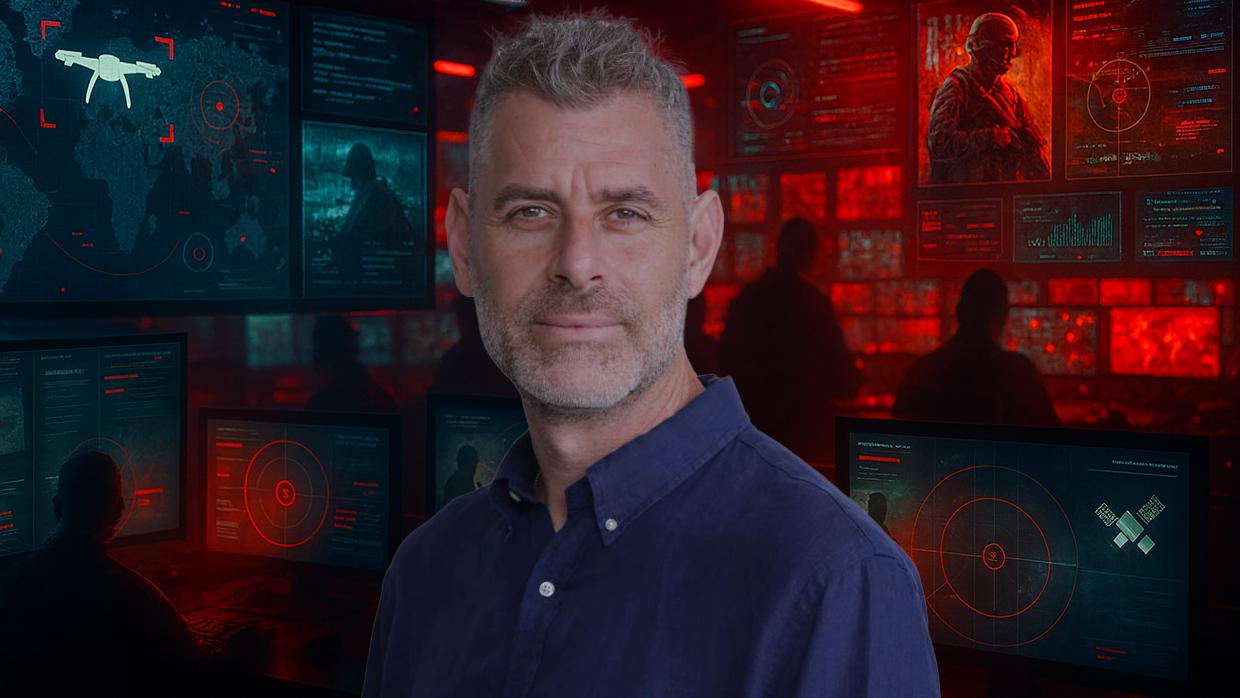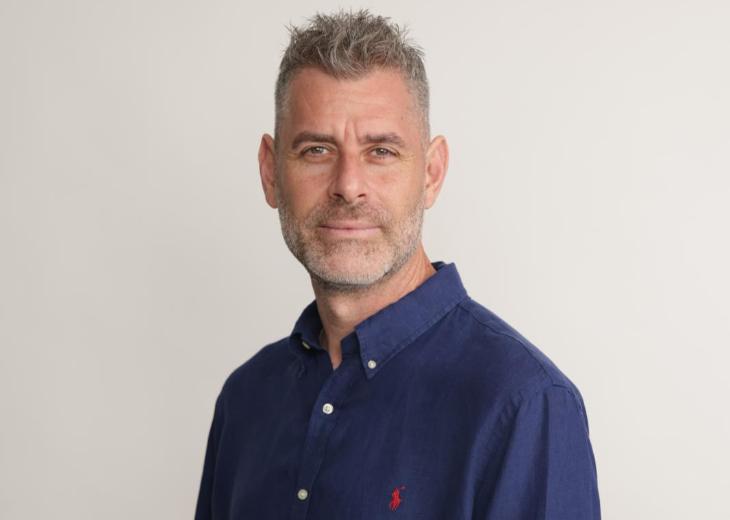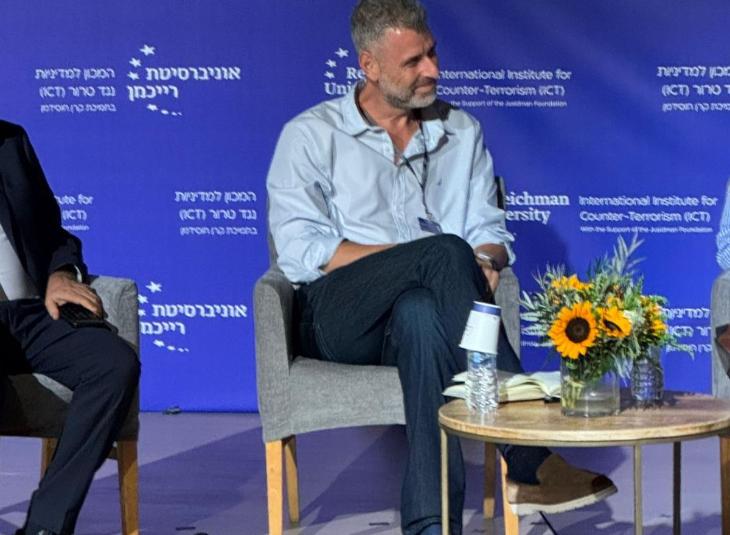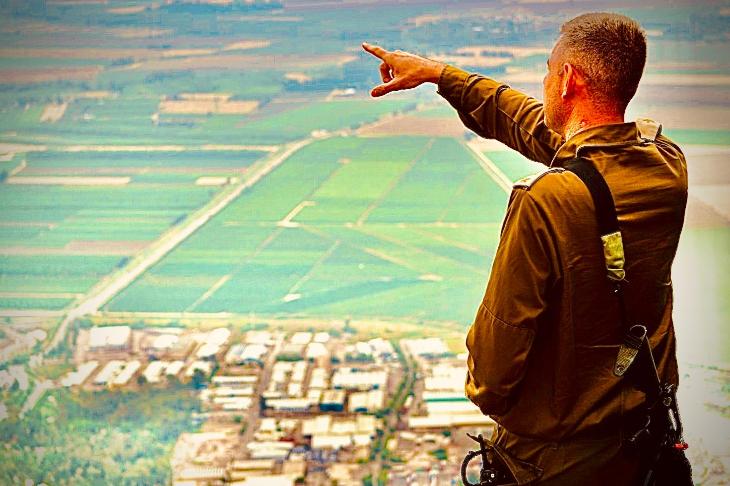 Wikipedia’s Antisemitism
Wikipedia’s Antisemitism


12 min read
5 min read
6 min read
14 min read
After witnessing the horrors of October 7th, veteran intelligence officer Guy Itzhaki found himself shattered—until an unexpected spiritual awakening began to piece him back together.
Guy Itzhaki is not the kind of man who startles easily.
A decorated IDF intelligence officer with more than 27 years of service, he spent his career on the front lines of Israel’s most shadowed threats. He fought in the Second Lebanon War, exposed Hezbollah tunnels along the northern border, tracked Iranian arms smuggling, and served for two years as assistant to then–Chief of Staff Benny Gantz. He lectured at the International Institute for Counterterrorism and even wrote a book on Hezbollah.
If anyone believed he had seen everything, it was Guy.
But on the morning of October 7th, 2023, something inexplicable jolted him awake at 6:30 a.m. There were no sirens, no alerts, no urgent calls—just a premonition that something was terribly wrong.
Only a few hours earlier, at around 3 a.m., Guy had received a cautious message from the army: intelligence teams were detecting unusual activity inside Gaza, but nothing conclusive. He had asked to be updated if the situation evolved and then went back to sleep. Now, with dawn barely breaking, his instincts told him he could not wait.
Guy understood that this was war—one unlike anything he had witnessed in his decades of service.
He called his deputy who sent an officer to the military headquarters. When the officer sent back images of white Hamas pickup trucks roaming freely through the streets of Sderot, Guy understood that this was war—one unlike anything he had witnessed in his decades of service.
Within an hour, the married father of four daughters was at military headquarters, watching live footage. “I read a lot of history books about the Yom Kippur War,” Guy said in an Aish.com interview, “But this was the first time in my life that I saw a scene from the Yom Kippur War. People were in shock. When you see these incidents on the screen, there are three options: one, that this is a nightmare and you’re dreaming, two, that that you are seeing a major IDF training exercise, or three – we messed up!”

In those chaotic early hours, there was much confusion. The scale of the attack, the number of infiltrations, the fate of the border communities—everything was fragmented, contradictory, or unknown. Instinctively, Guy called his wife, Anat, who held her own sensitive role in the army as head of HR for the special operations division. Leaving their four daughters at home with careful instructions to enter the bomb shelter during sirens, she drove straight to her unit.
At the time, Guy served as Head of the Influence Department, a unit created a decade earlier to counter hostile narratives by exposing the truth of how Israel’s enemies operate. His team’s work was part intelligence, part media, and part psychological warfare—documenting evidence from the battlefield and using it to reveal Hamas’s tactics to the world.
“For example,” Guy explained, “if you go inside a kindergarten in Gaza and inside, they have shells, or rifles, or hand grenades, or whatever, they will take pictures or videos of those things, and then we can use them online to show people this is how Hamas is using children as human shields.”
Within this department existed a specialized reservist unit responsible for tactical influence operations: collecting physical and visual proof from combat zones—photographs, videos, seized equipment—that could be used to show the world what Israeli soldiers were witnessing firsthand.
Realizing the magnitude of what was unfolding, Guy immediately called the unit commander with a direct order: get to the south and gather everything. Every image, every recording, every discarded weapon or phone—anything that could help piece together the truth.
He had no idea at the time that this decision would turn his unit into the central data hub of the massacre.
Guy’s team collected more than five terabytes of footage—raw, devastating material captured by terrorists’ GoPro cameras, their phones, and security systems of the kibbutzim. Guy watched every single video.
Over the next four to five months, Guy’s team collected more than five terabytes of footage—raw, unfiltered, devastating material captured by terrorists’ GoPro cameras, their phones, and security systems in the attacked kibbutzim. His department organized the footage that was eventually shown to Prime Minister Netanyahu, President Biden, Secretary of Defense Austin, world leaders, diplomats, and major international media outlets.
And throughout this period, Guy personally watched every single video.
But the screens—horrific as they were—did not prepare him for the moment he decided to see the aftermath with his own eyes.
On October 9th, two days after the massacre, Guy, his assistant, and their driver drove to Kfar Aza and then to Kibbutz Be’eri. He had braced himself, he thought. He was a third-generation Holocaust survivor. He had stood inside Nazi death camps five times. He had spent his life studying the darkest corners of human cruelty.
“Nothing prepared me for what I saw.” Stepping into Kfar Aza, Guy felt the axis of his life tilt.
“It wasn’t a death camp—that’s not quite right. It was hell on earth.”
“It was…” He paused, searching for a word. “It wasn’t a death camp—that’s not quite right. It was hell on earth.”
Guy recalled, “On Monday morning, it was still burning. Houses were still burning. I remember walking in the streets of Kfar Aza and we have terrorists that are fighting against us in the row next to us. I remember walking inside houses and moving between one body and another. A body of a woman that lies on the washing machine, a body of a dog, a body of her husband, a body of a baby… Just bodies. I remember the road that goes there. I told my driver, ‘Listen, don't look to the side, just drive, straight, because you can see bodies after bodies after bodies.’ I was there a couple of hours, and then I went back.”
Back home that night, the dam broke. Guy burst into tears. “I'm not an emotional guy,” he says. “I'm not used to crying. I was at a point where I needed to break. I needed to release some of my feelings. And since then, I can't sleep at night. I have nightmares. For the first couple of months, I was constantly crying every night.”
The diagnosis came later— Post-Traumatic Stress Disorder —but Guy already knew something inside him had shattered.
His life would begin to change in ways he never anticipated.
Before the war, Guy had planned on retiring from the army, spending more time with his family, and working on civilian projects. In the six months after October 7th, Guy continued leading the Influence Department through the war’s most intense period. But when his successor finally took over, he stepped away from the army for the first time in more than 25 years. He expected a smooth transition into civilian life—a chance to rest, reset, and spend time with his family.
Instead, he walked straight into the emptiness left behind by trauma.
“For the first time in my life, I came back home without my encrypted military phone, without any responsibility, and in the first couple of weeks, I was broken. I couldn't pull myself together. I was in wars before, I was in Gaza, in Lebanon, in the Judea and Samaria area. I was shot at, and I shot at the enemy. I lost friends. This was something else.”
Then, one day, something small but life-altering happened.
Guy opened his closet and sitting on a shelf was a simple bag containing the tallit and tefillin he had received as a wedding gift from his father-in-law. He had barely touched them in years. Guy didn’t grow up religious; his wife, Anat, came from a more observant background, but their home life settled into a middle ground—kosher kitchen, Jewish holidays, but no Shabbat observance.
Guy hadn’t put on tefillin in years but something drew him to the bag.
“I think God saw me at my lowest and helped me get up.”
He didn’t know exactly why but he picked up the phone and called his brother-in-law, a rabbi, to ask how to put them on.
Looking back, Guy speaks of that moment with emotion: “I think God saw me at my lowest and helped me get up.”
What began as a single act—a quiet, uncertain reaching—became the first step in a spiritual return. As Guy puts it, he felt an urgent need to rebuild meaning. “This world is a corridor to the next,” he said. “As long as I’m in this corridor, I want to become a better person. I want values that are connected to our roots. And I want to let go of the evil I saw.”
So, he began putting on tefillin every morning.

The connection Guy experienced as he began praying and reciting Psalms daily enabled him to rise above his brokenness and slowly return to everyday life. At first, he prayed alone, at home. “I needed a place to myself, with myself, because when you are praying, that's the only time that I have to think, to breathe, to be with yourself.”
Eventually, Guy ventured to the local synagogue. He’d been there before, on Jewish holidays and at Bar Mitzvah celebrations, but he’d never felt connected to the services.
“It was the first time that I came to a synagogue with the feeling of really wanting to be there, to open my eyes and ears, to understand what I'm doing there, to understand how to communicate with myself and how to start a conversation between me and God.”
Though he was afraid that he’d be criticized for doing things “wrong,” Guy discovered that the synagogue was a warm and welcoming place. “I found a beautiful community,” he said. “I felt at home.”
In addition to praying, Guy also began reading classic Jewish texts, from Ecclesiastes and the Talmud to The Paths of the Just. “I was looking for the truth, and I found it inside the ancient Jewish books. And one step at a time, I feel I’m in a very different position.”
Guy reflected, “This was the first time in my life as a grown-up that I did something for myself. Not for the military, not for the country, for myself. It helped me understand more about what I want to achieve, what I'm aiming for. It helped me become a better person, or aim to become a better person, and the only One that can say if I'm a better person or not is God.”
As Guy learned and connected to Judaism more, he decided to begin keeping Shabbat. This was, and remains, a struggle in many ways. On a practical level, it is challenging for his family and extended family, because he can no longer attend a Friday night dinner that is not within a walking distance. It is also challenging emotionally, because quiet times are difficult for Guy. “When you have PTSD, bad thoughts are looking for a place to get to you.”
He cherishes the extra time with his family. And when they’re not available, he leans on books, prayer, and reflection. Slowly, Shabbat is becoming not only a discipline, but a companion. “Shabbat is time for me to arrange my thoughts, to think more, to do less.”
Spiritual growth does not happen in isolation—it ripples through a family. His wife, Anat, who is processing her own trauma from the war, has been very supportive of Guy’s journey.
“My wife is my best friend,” he said simply. And throughout this vulnerable new chapter, that friendship held fast.
“My wife asked me to take it one step at a time, and this is what I'm doing.”
Still, Anat had concerns at first. She wondered how his newfound spirituality and observance would affect their home. “She asked me to take it one step at a time, and this is what I'm doing,” he says.
At first, Anat joined him in his explorations only to support him. But slowly, her own interest in Judaism began to grow. Their oldest daughter, now 18, also started expressing curiosity about her roots. Guy didn’t push, didn’t demand, didn’t expect—they each came to the journey in their own way, at their own rhythm.
Whatever direction his family takes, he will embrace it with love. He knows that, no matter what, they are there for each other.
Through it all, Guy continues to build a spiritual life that sustains him. Today he prays three times a day, speaking to God throughout the day.
“I feel that we are talking, always,” he says. “I know He’s listening. Even when I make mistakes.”
Guy’s anxiety still surfaces in unexpected ways. He becomes tense when his daughters are out late, compulsively checking the clock until he hears the door. He avoids television entirely; even news clips or hostage stories can trigger overwhelming waves of emotion. Sleep still comes in fragments, broken by nightmares.
“There isn’t an hour when I stop thinking about what I saw.”
“There isn’t an hour when I stop thinking about what I saw,” he admitted. “There isn’t a week that I’m not crying.”
Alongside the grief sits a heavy, inexplicable guilt. He wasn’t part of the decision-making circle before October 7th, yet he feels personally responsible for what happened—an emotional burden many soldiers and intelligence officers share.
Through all of this, Guy returns again and again to the one place where the pain doesn’t swallow him: his connection with God.
“Besides my wife and my girls,” he said, “this process with God is maybe the best thing I have. It’s kept me alive, not physically, but mentally. It gave me meaning, gave answers to my questions. It’s the main thing that helps me keep my head above the water.”

Guy says that before the war, he carried “tons of ego” from his years in the military, from the sense of command and capability that defined his life. But the trauma stripped that away. “I thought the story was about me,” he reflects. “Now I understand the story is about me and Him, and about becoming a better person in this world.”
Even as he continues to heal, Guy refuses to let trauma freeze him in place. Ambition still burns in him—not for recognition, but for purpose. “We need to live,” he says. “I want to do good. I want to succeed. I want to help.”
Today, Guy is channeling his decades of intelligence and security experience into new initiatives in Israel and North America. His focus spans security consulting, influence strategy, community protection, and emerging technologies. Above all, he is driven by the desire to strengthen and safeguard Jewish communities worldwide.
He speaks with urgency: “Right now, the Jewish community around the world is in a very weak position. The next ten years are going to be very hard for Jews.”
He wants to use technology and intelligence methods—tools he mastered in the military—to fight antisemitism and reshape public perception. For him, this isn’t only strategy; it’s personal restitution, a way to transform pain into impact.
To succeed, he believes Jewish communities must think more cohesively. “We need all Jewish communities in every country to unite,” he explained, “to build a shared narrative, a clear message, a coordinated influence strategy. We have to be determined, persuasive, and accurate.”
His vision is practical but bold: a new infrastructure for Jewish resilience, informed by the lessons—especially the failures—of October 7th. Preparedness, he says, begins with humility: “the right team, in the right place, who don’t think they know everything.” With that, the IDF—and the Jewish world—can meet the challenges ahead.

Like the Nazis, these war criminals took photos. These photos should be used as evidence of crimes against humanity in a tribunal similar to Nuremberg; the world must know there are not two narratives here: there is good and evil and they demonstrate pure evil.
You're right, of course, but we must realize that we're living in a world that's vastly different from that of post WWII: Then, the world sought retribution for the millions of gentile civilians who perished at the hands of the Nazis, ym"s.
With regard to the the genocide of the Jews (note that this term was coined at that time and is being used correctly here, unlike its use in today's largely antisemitic media!), the world that had been aware but remained silent about the unspeakable atrocities during the Holocaust was apparently trying to make amends by seeking justice against German war criminals.
Though we must pursue it, it's clear that the ultimate justice is not a matter for this world.
Numbers 6:24-26 came to mind as I read through this very human reaction to the atrocities of Oct 7.
This was emotional. As someone with ptsd, it rang a bell in my heart and soul. Amazing
Great sharing. Thanks for this. Shalom.
One more proof (though no proof is needed) that everything that happens, including what we perceive as"bad", is for the best. After all, He created us and has our best interests at heart.
From my experience, sometimes we may be granted the ability to understand why "bad and terrible" things were really for our own good. This may happen after days, months or years, or only after we leave this world, but eventually we will understand.
May you go from strength to strength, and may each day bring you closer to God and healing.